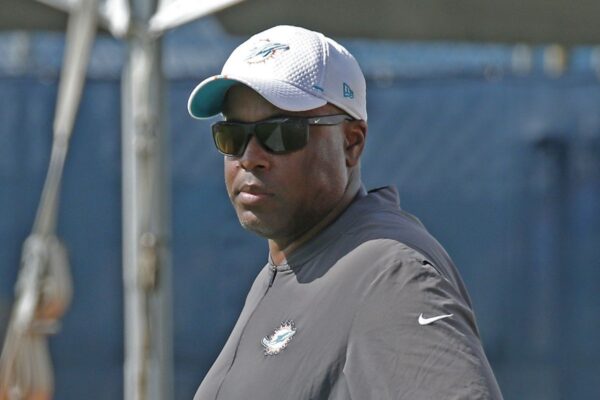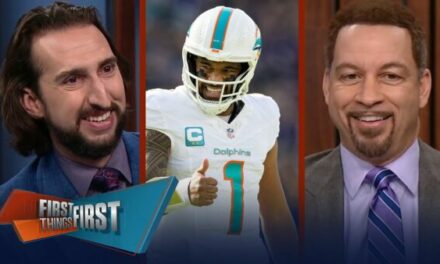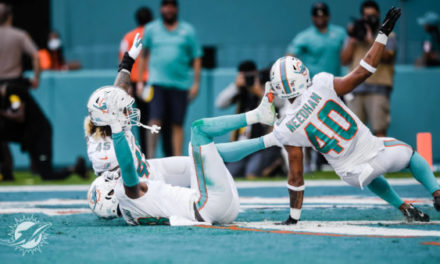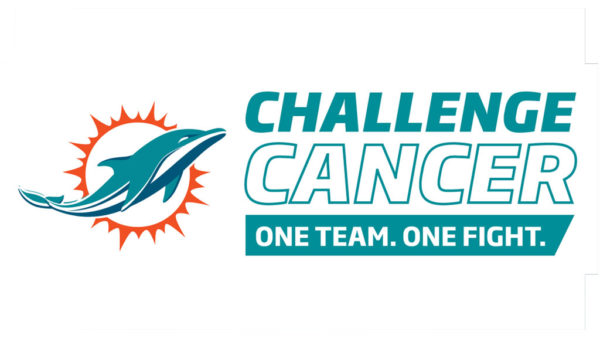
With the Miami Dolphins only having four picks (54, 84, 197, and 238) available to them in the 2023 NFL Draft, Chris Grier & Co. will need to make the most of their picks this year. They will undoubtedly have to do better than they did last year when the only rookie that provided any meaningful snaps from their draft class was third-string quarterback Skylar Thompson. Kader Kohou certainly contributed, but he was a UDFA pick-up and the only rookie that had more than 250 total snaps (898 defensive snaps). While the majority of the Dolphins draft picks from 2022 and 2023 have gone towards trading for veteran cornerstone pieces on the team (Tyreek Hill, Jalen Ramsey, and Bradley Chubb), this puts all the more emphasis on the front office getting these drafts right this year as they push towards a Super Bowl run in the next two to three years.
The Dolphins’ current salary cap situation as it stands will prevent them from making any other free agent acquisitions until at least June 1st, as they can clear another thirteen million dollars from the release of Byron Jones. After this current crop of free-agent acquisitions, the Dolphins still have a couple of positions of need that need to be filled (RT, TE, LG, and NT) Below are some options in the draft that would help fill the two most pressing needs the Dolphins still have.
Round 2, Pick 51
Right Tackle
Jaelyn Duncan, 6-6 306lbs, Maryland, Relative Athletic Score: 9.46
NFL Comparison: Austin Jackson
Dolphins fans will cringe at the thought of a re-do pick of Austin Jackson, but Duncan has several things going for him. First, he’s one of the most athletic offensive tackles in the NFL Draft this year. He has great feet and long arms to keep pass rushers at bay. In the run game, he can get to the second level to seal off linebackers and spring open running lanes for his running backs. He will need to work to get stronger, but with an NFL training room, that shouldn’t be much of an issue.
Anton Harrison, 6-4 312lbs, Oklahoma, Relative Athletic Score: 8.07
NFL Comparison: Dion Dawkins
Anton Harrison is another tackle that will certainly need to add muscle to his frame, but what he lacks in pure strength he makes up for in his athleticism and smarts. He comes from a similar zone-blocking system in Oklahoma that emphasizes working together as a whole unit and walling off defenders rather than bullying the other team and moving guys out of the way. His transition to the NFL will be determined based on whether he can transition his technique over to the NFL level, but his familiarity with the zone-blocking scheme should help with that transition.
Matthew Bergeron, 6-5 318lbs, Syracuse, Relative Athletic Score: 9.69
NFL Comparison: Joel Bitonio
While at Syracuse, Matthew Bergeron was an excellent run blocker, consistently neutralizing the opponent in front of him. He has experience playing at both tackle spots. He is strong and carries his weight well on his frame. His run blocking will immediately transition to the NFL with no problem. While his athleticism covered his warts in pass protection at the college level, he must improve his footwork and technique at the NFL level. His functional play strength, though, is no issue. With good NFL coaching, he could turn into a pro-bowl-level tackle.
Tight End
Darnell Washington, 6-7 265lbs, Georgia, Relative Athletic Score: 9.85
NFL Comparison: Marcedes Lewis
While it probably wouldn’t surprise anyone to see a Jason Peters-type transition for Darnell Washington, most think his best position is probably tight end due to his immense size, soft hands, and overall athleticism for a man his size. He complements what the Dolphins want to do these days offensively with having wide receivers Tyreek Hill and Jaylen Waddle on the roster. In the run game, he’s a dominant blocker, taking on linebackers and defensive ends alike with relative ease. In the passing game, his soft hands and ability to catch the ball outside of his frame lend well to winning jump/contested balls over the middle and in the red zone.
Sam Laporta, 6-3 245lbs, Iowa, Relative Athletic Score: 9.27
NFL Comparison: George Kittle
Sam Laporta might be slightly undersized by NFL standards, but his overall game more than makes up for it. Laporta is RAC (run after catch) specialist, consistently making the first man miss and gaining extra yards after contact. He has soft hands and route savvy, making separating from linebackers and safeties a bit easier. He will need to work on bringing in contested catches, though. In the run game, he gives great effort, consistently making his presence felt. He will need to work on his technique at the next level, though, as he can miss his target too often. Overall, the frenetic energy he plays with reminds people a lot of a fellow former Iowa tight end, George Kittle.
— DolphinsTalk.com (@DolphinsTalk) March 21, 2023
Round 3, Pick 84
Offensive Tackle
Tyler Steen, 6-6 321lbs, Alabama, Relative Athletic Score: 9.67
NFL Comparison: Greg Little
Tyler Steen started his college career as a defensive tackle at Vanderbilt and ended it as the starting left tackle at Alabama. His inexperience at the position is both positive and negative. Starting with the negatives, his technique, hand placement, and overall awareness at tackle are all lacking, due to only playing the position for a few years now. The positives are that he is strong, can move opponents off the ball with relative ease, and deals with bull rushes as well. He also fires off the ball with good explosiveness to beat defenders to the spot. He will certainly need to work on his technique in the NFL, but he certainly has the potential to be a starter with the right coaching.
Blake Freeland, 6-8 302lbs, BYU, Relative Athletic Score: 9.89
NFL Comparison: Kolton Miller
Blake Freeland is a very tall and athletic tackle who moves with ease to mirror and slide his feet in pass protection and cut off defenders, and wall them off in the run game. His issue is with play strength, especially for how tall he is. He will struggle with leverage in the NFL, but with the proper NFL strength training regiment, he should have no problem putting on the muscle required to be a good NFL starter.
Tight End
Tucker Kraft, 6-5 255lbs, South Dakota State, Relative Athletic Score: 9.58
NFL Comparison: Hunter Henry
A classic Y-Tight End, Tucker Kraft possesses a complete overall game. While he doesn’t excel in either part of the game, he also doesn’t have a weak spot either. He has excellent hands, with above-average run-after-catch ability and decent route running as well. His effort in the run game is great, and his technique is above most rookies coming into the NFL. Like most college prospects, though, he has plenty to work on to become a quality starter.
Luke Schoonmaker, 6-5 251lbs, Michigan, Relative Athletic Score: 9.85
NFL Comparison: Dawson Knox
Similar to Tucker Kraft, Schoonmaker is a well-rounded tight end that can do a little bit of everything. Having been in Jim Harbaugh’s offensive system, he is more than familiar with run blocking and the technique it takes to win in that phase of the game. In the passing game, his athleticism wasn’t utilized enough in Michigan’s offense, which makes his potential for more production in the NFL promising. His athletic profile lends to the belief that he can do multiple things in the passing game, but projections don’t always mean production. Overall though, Schoonmaker could be a steal in the third round when you combine his athleticism, run-blocking prowess and experience, and potential to impact the passing game.
(Credit to @MathBomb on Twitter for the Relative Athletic Score numbers)














Why can’t Dolphin fans/writers ever get our second round pick right? It is #51, not #54.
And this silly obsession putting the OL first no matter what the value of the board is continues to baffle me.
Wouldn’t Miami be better off with another secondary piece (we do have age and injuries to consider in the back four) than an Austin Jackson clone? I’m running away from the next guy I hear is “very athletic but needs seasoning as he misses assignments and can’t always stay in front of his defender”. Hard no, don’t need two of those on the roster, get a veteran to play RT.
You could sell me on Cody Mauch a lot easier than Duncan or Harrison but I still don’t believe that in a draft with four selections and a scouting team that misses on OL more often than not, that the right move is to take an OL with either day 2 pick.
Many of the LB, DB, RB and TE options from picks 50-90 offer more value than the project OL we’d reach for at those spots
Looking at this draft it is set up for Miami to grab a versatile starter at TE, a future starter at CB or S, a younger RB who can get 10-20 touches as a rookie or a LB who can cover TE’s and stop the run. All of these traits offer more value, imo, than another reach for a RT or guard.